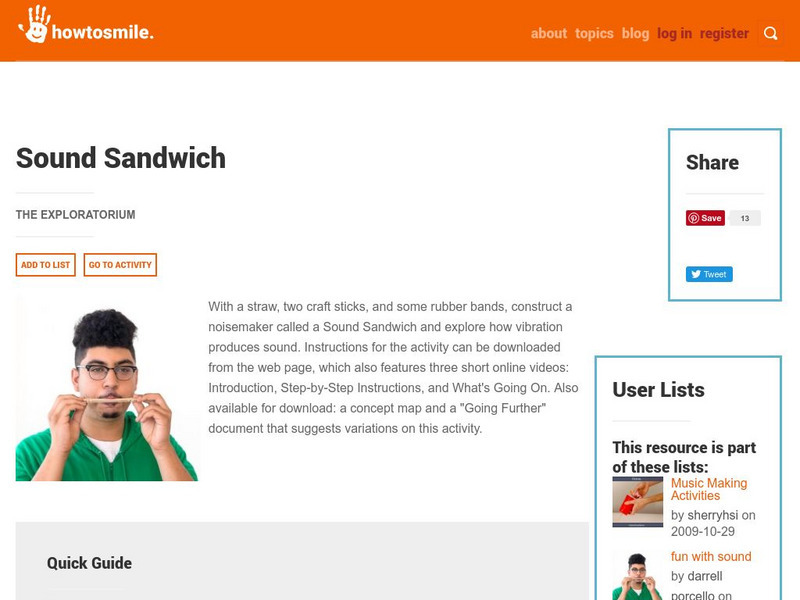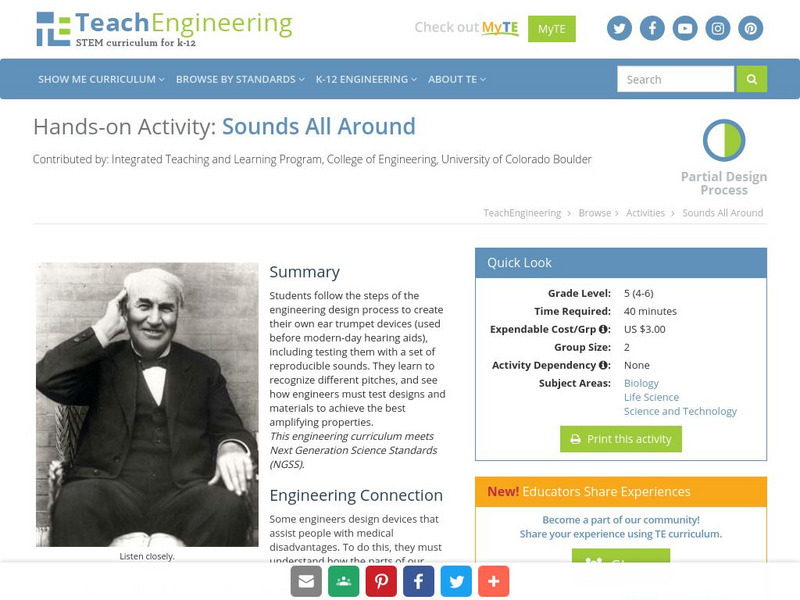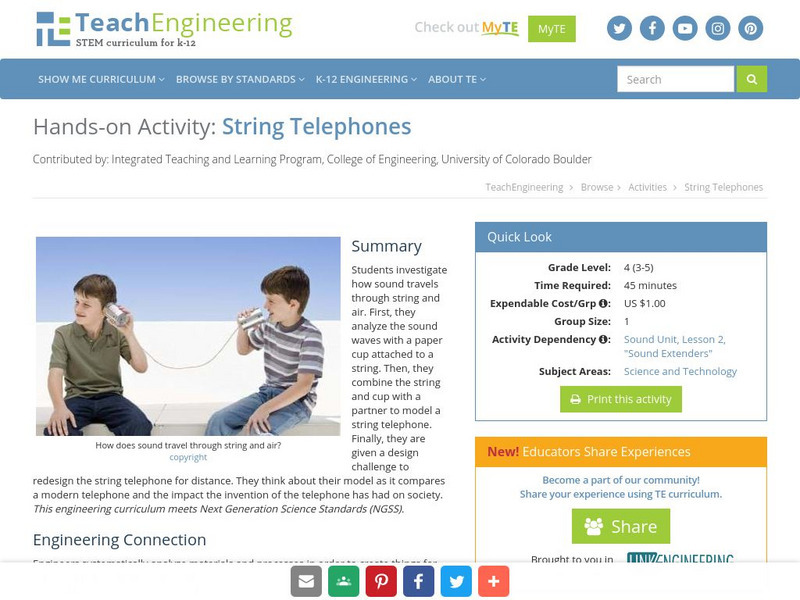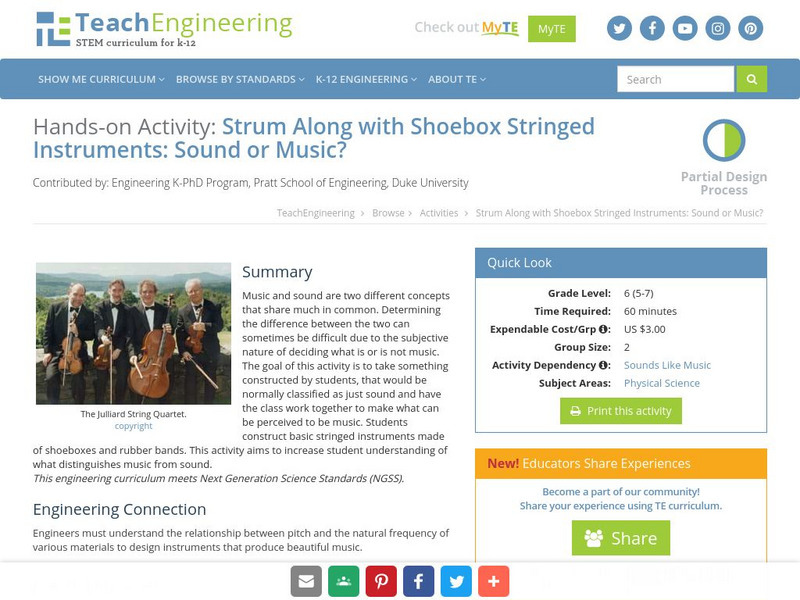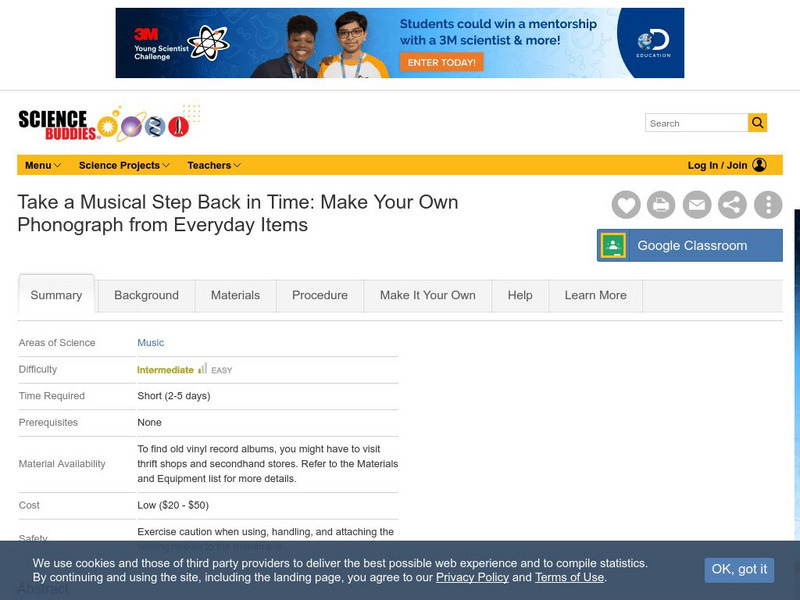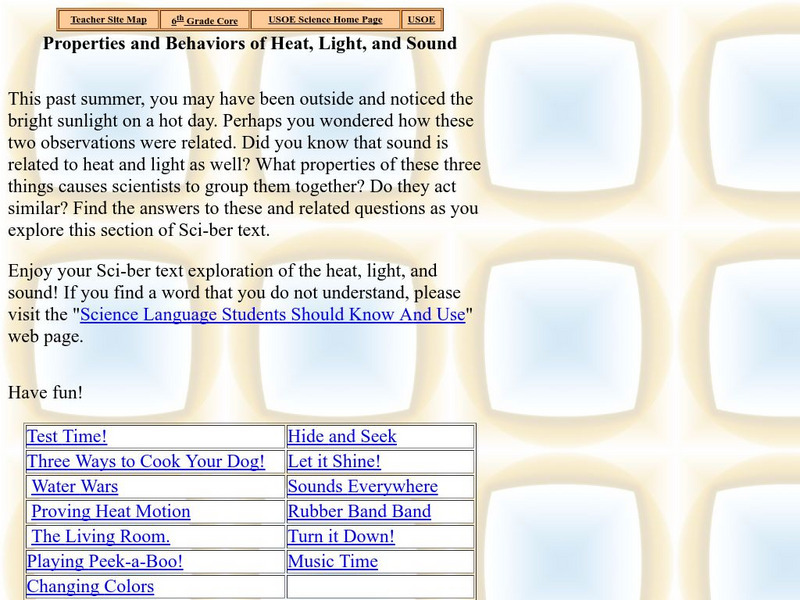Georgia Department of Education
Ga Virtual Learning: Sound
Through multiple animations and interactive activities, this module allows students to investigate the properties of sound.
Other
How to smile.org: Sound Sandwich
Students discover how vibrations produce sound by making this sound sandwich out of everyday materials. Lesson plans include three videos that give an introduction, step-by-step demonstration, and an explanation of the science behind the...
TeachEngineering
Teach Engineering: Sounds All Around
Students follow the steps of the engineering design process to create their own ear trumpet devices (used before modern-day hearing aids), including testing them with a set of reproducible sounds. They learn to recognize different...
TeachEngineering
Teach Engineering: Musical Images
Students are introduced to the concept of the image of music. After listening to a song, they draw images of it by deciding where different musical instruments were placed during recording. They further investigate audio engineering by...
TeachEngineering
Teach Engineering: String Telephones
Students investigate how sound travels through string and air. First, they analyze the sound waves with a paper cup attached to a string. Then, they combine the string and cup with a partner to model a string telephone. Finally, they are...
TeachEngineering
Teach Engineering: Form vs. Function
Students model and design the sound environment for a room. They analyze the sound performance of different materials that represent wallpaper, thick curtains, and sound-absorbing panels. Then, referring to the results of their analysis,...
TeachEngineering
Teach Engineering: Strum Along
Music and sound are two different concepts that share much in common. Determining the difference between the two can sometimes be difficult due to the subjective nature of deciding what is or is not music. The goal of this activity is to...
TeachEngineering
Teach Engineering: Robot Sensors and Sound
Using microphones connected to computers running Audacity software, student teams experiment with machine-generated sounds and their own voices and observe the resulting sound waves on the screen, helping them to understand that sounds...
TeachEngineering
Teach Engineering: What's a Wavelength?
Students measure the wavelength of sounds and learn basic vocabulary associated with waves. As a class, they brainstorm the difference between two tuning forks and the sounds they produce. Then they come up with a way to measure that...
TeachEngineering
Teach Engineering: Sound and Light
The Sound and Light unit provides students with an understanding of sound and light waves through the theme of the "Sunken Treasure," a continuous story line throughout the lessons. In Lessons 1-5, students learn about sound, and in...
TeachEngineering
Teach Engineering: To Absorb or Reflect, That Is the Question
This is the last of five sound lessons, and it introduces acoustics as the science of studying and controlling sound. Learners learn how different materials reflect and absorb sound.
TeachEngineering
Teach Engineering: Sounds Like Music
Music can loosely be defined as organized sound. The instructional activity objectives, understanding sound is a form of energy, understanding pitch, understanding sound traveling through a medium, and being able to separate music from...
TeachEngineering
Teach Engineering: How Does a Sound Sensor Work?
Students learn about how sound sensors work, reinforcing their similarities to the human sense of hearing. This lesson and its associated activity enable students to appreciate how robots can take sensor input and use it to make...
Other
Deafness Research Uk: How the Ear Works
A collection of several images explains how the ear makes us hear sound.
Other
Noise: A Hazard for the Fetus and the Newborn
A research paper on the effects of noise pollution on the unborn and the newborn. Prepared by the American Academy of Pediatrics.
Science Buddies
Science Buddies: Project Ideas: Make a Phonograph From Everyday Items
In this physics science fair project, the student will use common materials to play back sound from a vinyl record album. The student will investigate what kinds of materials produce the best sound. The Science Buddies project ideas are...
Utah State Office of Education
Utah State Office of Education: Force, Energy, & Motion
A unit on energy, force, and motion presented with interactive and classroom activities. Students gain an understanding of weight, mass, potential and kinetic energy, sound, and heat with this engaging resource.
PBS
Pbs Learning Media: Pitch: Straw Kazoo
This video segment, adapted from ZOOM, explores the different sounds that a simple drinking straw can produce when you cut the straw and blow into it. [1:56]
Technovation
Curiosity Machine: Challenges: Make a Signal Horn
Build a signal horn to make low-frequency sounds that can be heard from far away in this STEM lesson. Use this interactive site to document your design process. Included on the site is a video explaining a possible solution to the problem.
Utah State Office of Education
Utah Science: Properties and Behaviors of Heat, Light and Sound
How can scientists lump heat, light and sound together when investigating properties and behaviors? This learning module will address that question through a series of activities.
CK-12 Foundation
Ck 12: Wave Speed Calculations
[Free Registration/Login may be required to access all resource tools.] Students investigate and analyze characteristics of waves, including velocity, and calculate the relationship between wave speed, frequency, and wavelength.
Other
Noise Pollution Clearninghouse: Noise a Health Problem
Booklet by the Environmental Protection Agency. Covers physical effects on major body systems, as well as emotional impacts. Lengthy, but well indexed.
University of Florida
Florida Museum of Natural History: Physical Science
This guide focuses on four physical science topics that fascinate children and scientists alike. They are motion, magnets, sound, and light. With your guidance and support, these topics provide children with many opportunities to explore...
Other
Bscs: Content Background for Sound
This document will give you "extra" information and opportunities to build your understanding of sound so that you can be better prepared to facilitate the sound lessons with your students.



